Understanding the Importance of Singer Sewing Machine Manuals for Old Machines
Singer sewing machine manuals are crucial for restoring and maintaining vintage models, providing essential guidance on operation, troubleshooting, and parts replacement to preserve functionality and historical value.
Singer sewing machine manuals are detailed guides providing essential information for operating, maintaining, and troubleshooting vintage Singer models. These manuals are tailored to specific machines, such as the Singer AS 241353 and Singer 680U, offering step-by-step instructions for setup, threading, and stitch techniques. They also cover maintenance routines, parts diagrams, and repair tips, ensuring users can keep their machines functional. Enthusiasts often rely on these manuals to restore and preserve their vintage Singer machines, making them indispensable for both novice and experienced sewists. The manuals serve as a vital resource for understanding and caring for these historic sewing machines.
Why Manuals Are Essential for Restoring and Maintaining Old Singer Machines
Singer sewing machine manuals are vital for restoring and maintaining vintage models, offering detailed guidance on troubleshooting, parts replacement, and maintenance routines. They provide specific instructions for models like the Singer AS241353 and Singer 680U, addressing issues such as stitch locking and needle compatibility. Manuals also include diagrams and technical drawings to help users identify and replace worn or broken components, ensuring proper functionality. Without these manuals, enthusiasts face challenges in accurately diagnosing and repairing their machines, making them indispensable for preserving the longevity and performance of classic Singer sewing machines.
Historical Background of Singer Sewing Machines and Their Manuals
Singer sewing machines have a rich history dating back to the 1800s, revolutionizing sewing with durable, user-friendly designs. Their manuals, first introduced alongside early models, provided detailed instructions for operation, maintenance, and repair. Over the years, Singer expanded its product line, creating specialized manuals for models like the heavy-duty HD4411 and vintage favorites such as the 221K, 66K, and 99K. These manuals evolved to include technical drawings and troubleshooting guides, becoming invaluable resources for enthusiasts. Today, both original and digital versions of Singer manuals remain essential for preserving and restoring these iconic machines, ensuring their legacy endures for future generations.

Types of Singer Sewing Machines and Their Corresponding Manuals
Singer offers various machine types, including mechanical, treadle, and electric models, each requiring specific manuals tailored to their unique features and maintenance needs.
Overview of Popular Vintage Singer Models (e.g., 201K, 99K, 66K, 221K)
Popular vintage Singer models like the 201K, 99K, 66K, and 221K are highly sought after by collectors and sewists. The 201K is known for its durability and versatility, while the 99K is prized for its portability and ease of use. The 66K is a workhorse, ideal for heavy-duty sewing, and the 221K, or Featherweight, is renowned for its lightweight design and precision stitching. Each model has unique features, making their corresponding manuals essential for understanding operation, maintenance, and troubleshooting. These manuals provide detailed insights into the specific needs of each machine, ensuring optimal performance and longevity.
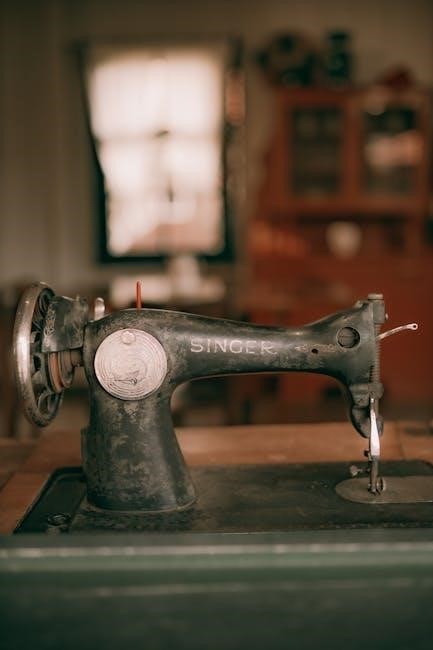
Differences in Manuals for Heavy-Duty vs. Standard Vintage Models
Manuals for heavy-duty Singer models, like the 201K and 31K, often include detailed instructions for handling thick fabrics and heavy use. These manuals emphasize robust maintenance routines, such as oiling specific mechanical parts and adjusting tension for heavy-duty stitching. In contrast, standard vintage models like the 99K and 66K have manuals focused on general sewing tasks, with simpler maintenance guides and fewer specialized features. Heavy-duty manuals may also include diagrams for industrial-grade components, while standard models focus on domestic use. Understanding these differences is crucial for proper machine care and operation.
Specialized Manuals for Singer Machines with Unique Features
Singer machines with unique features, like embroidery or quilting, require specialized manuals. These guides offer detailed instructions for operating and maintaining advanced functions. They include specific troubleshooting sections and diagrams for unique mechanisms. Users benefit from part replacement information tailored to their machine’s special features. These manuals are crucial for optimizing the performance of Singer machines designed for specialized tasks, ensuring longevity and functionality. They cater to both novice and experienced sewists, providing comprehensive support for intricate stitching and customization options, making them indispensable for owners of these distinctive models.
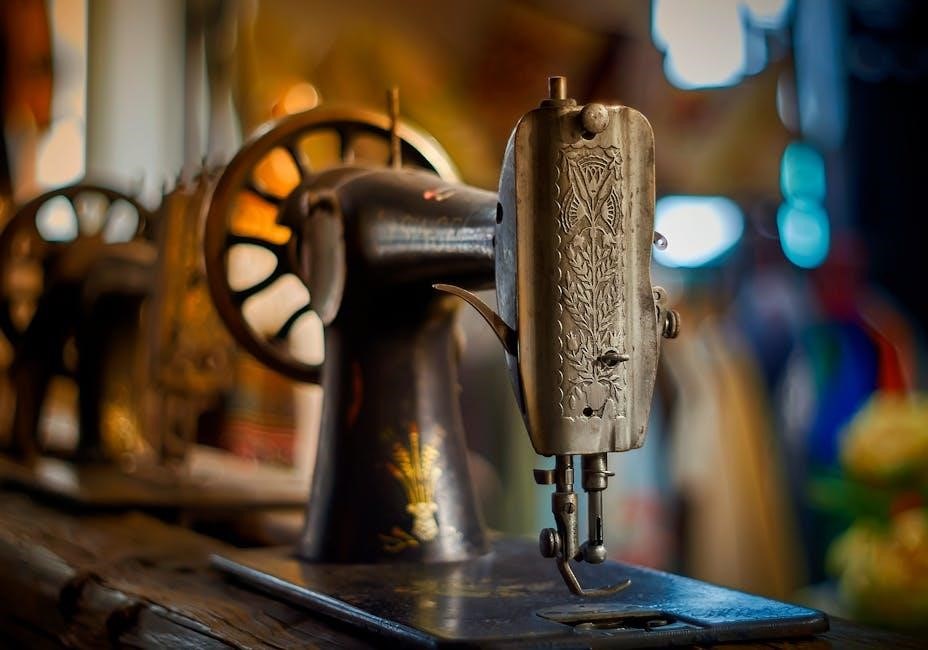
Where to Find Singer Sewing Machine Manuals for Old Machines
Find Singer sewing machine manuals at the official Singer website, vintage sewing communities, antique shops, thrift stores, or online marketplaces like eBay. Digital archives and PDF versions are also available online for easy access and download.
Official Singer Website and Resources
The official Singer website is a primary source for manuals, offering free downloads for various models. Users can search by model number or machine type to find specific guides. Singer provides detailed instructions, parts lists, and troubleshooting tips. Their resources are updated regularly, ensuring compatibility with both vintage and modern machines. Additionally, Singer’s customer support can assist with locating rare or discontinued manuals. These official resources are invaluable for maintaining authenticity and functionality, making them a must-visit for enthusiasts and collectors of vintage sewing machines.
Vintage Sewing Machine Communities and Forums
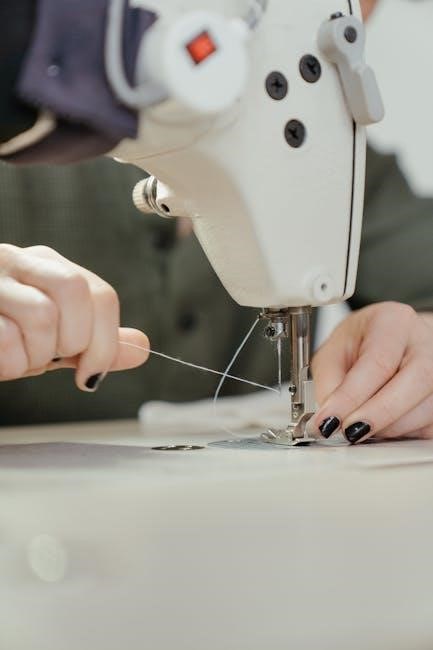
Vintage sewing machine communities and forums are invaluable resources for locating Singer sewing machine manuals. Platforms like Singer Collectors and ISMACS (International Sewing Machine Collectors’ Society) host extensive archives and discussions. Members often share scanned manuals, repair tips, and historical insights. These forums foster collaboration, allowing enthusiasts to exchange knowledge and solve restoration challenges. Many rare manuals are accessible through these groups, making them a lifeline for owners of vintage Singer machines. While some manuals may require membership or a small fee, the collective expertise within these communities is priceless for preserving and maintaining classic sewing machines.
Antique Shops, Thrift Stores, and Online Marketplaces
Antique shops, thrift stores, and online marketplaces are excellent sources for finding Singer sewing machine manuals. Many vintage Singer machines are sold with their original manuals, which can be discovered in antique shops or second-hand stores. Online platforms like eBay, Etsy, and specialized vintage sewing marketplaces often list rare or out-of-print manuals. These platforms cater to collectors and enthusiasts, offering both physical copies and digital versions. When purchasing from these sources, ensure the manual matches your machine’s model and condition. This method is ideal for those who prefer tangible copies or rare editions that are no longer available elsewhere.
PDF Versions and Digital Archives of Singer Manuals
PDF versions and digital archives of Singer sewing machine manuals are a convenient option for owners of vintage machines. Official Singer websites, sewing enthusiast forums, and digital libraries often host these manuals, making them easily accessible. Platforms like ManualsLib, ManualsOnline, and even eBay may offer free or paid downloads. These digital files are ideal for quick reference and eliminate the need for physical storage. Ensure the PDF matches your machine’s model by cross-referencing the model number. Digital archives also preserve rare manuals, safeguarding the knowledge for future generations of sewing enthusiasts and restorers;
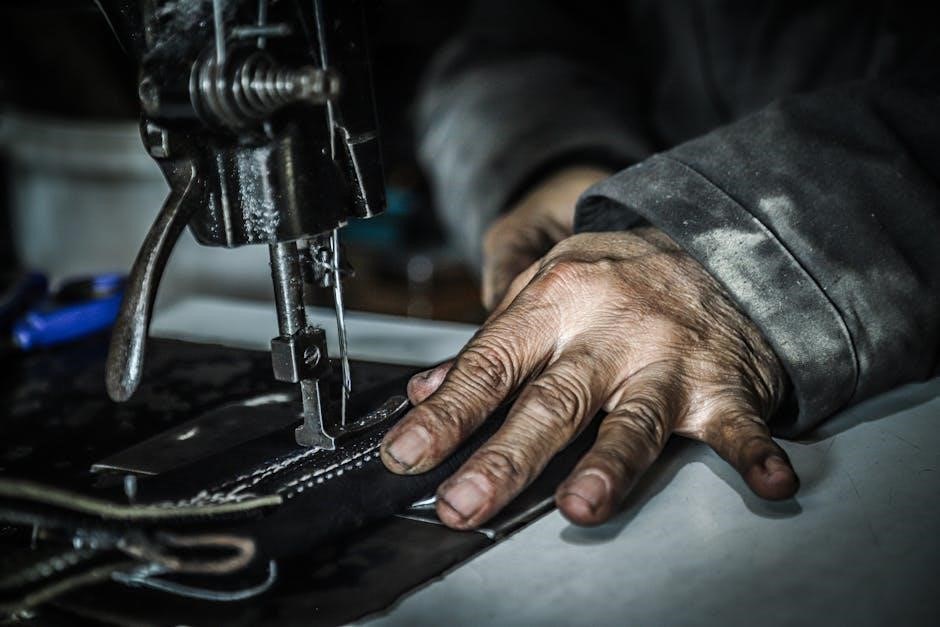
Contents of a Typical Singer Sewing Machine Manual
A typical Singer manual includes setup instructions, threading guides, maintenance tips, stitch pattern explanations, parts diagrams, and troubleshooting advice, ensuring comprehensive guidance for optimal machine use.
Setup and Threading Instructions
Singer manuals provide detailed setup and threading instructions, ensuring proper machine assembly and operation. Step-by-step guides explain how to attach parts, wind bobbins, and thread needles correctly. Clear diagrams illustrate the threading path, highlighting tension discs and take-up levers. Instructions vary slightly by model but emphasize consistency for optimal stitching. Troubleshooting tips address common issues like uneven tension or thread breakage. These sections are crucial for achieving precise stitches and maintaining machine efficiency, especially for vintage models with unique threading requirements.
Maintenance and Troubleshooting Guides
Singer manuals include comprehensive maintenance and troubleshooting sections to keep old machines functioning smoothly. Regular tasks like oil changes, cleaning, and lubrication are detailed to prevent wear and tear. Troubleshooting guides address common issues, such as uneven stitching or machine noise, offering step-by-step solutions. Diagrams often accompany text, illustrating how to inspect and replace worn parts. These guides empower users to resolve problems independently, ensuring longevity and performance. By following these instructions, owners can maintain their vintage Singer machines effectively, preserving their functionality for years to come.
Operating Techniques for Different Stitch Patterns
Singer manuals provide detailed guidance on operating techniques for various stitch patterns, ensuring optimal performance. Instructions cover settings for straight stitching, zigzag, and decorative patterns, including thread tension adjustments and presser foot usage. Tips for handling different fabrics and managing stitch length are included. Troubleshooting advice helps resolve issues like uneven stitches or thread breakage. These guides enable users to master diverse stitching techniques, enhancing creativity and precision in sewing projects. By following the manual, users can unlock their machine’s full potential and achieve professional-quality results consistently.
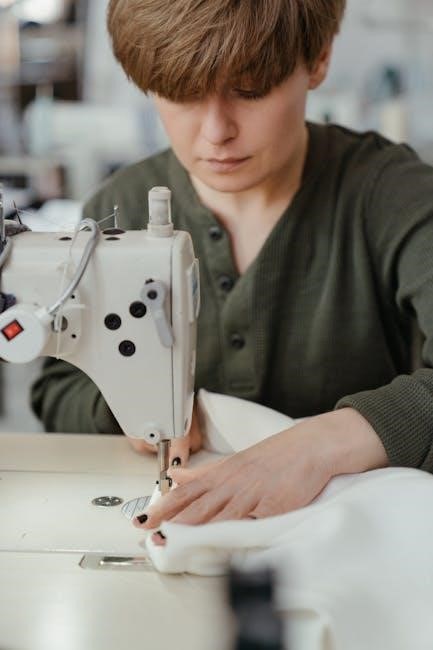
Parts Diagrams and Replacement Information
Singer sewing machine manuals include detailed parts diagrams, essential for identifying components and understanding their functions. These diagrams, often labeled with part numbers, help users locate and replace worn or damaged parts. Replacement information typically lists compatible parts, sources for procurement, and step-by-step installation guides. This section is vital for maintaining and restoring vintage machines, ensuring proper functionality. By referencing these diagrams and instructions, users can accurately repair or upgrade their machines, preserving their longevity and performance. This resource is invaluable for both novice and experienced sewists working with classic Singer models.

Restoring and Using Old Singer Sewing Machines
Restoring vintage Singer machines involves detailed cleaning, lubrication, and part replacement. Manuals guide users through troubleshooting, maintenance, and operation, ensuring machines function like new. This process transforms neglected sewing machines into fully functional, reliable tools for crafting and sewing, preserving their heritage while enabling modern use.
Step-by-Step Guide to Restoring a Vintage Singer Machine
Begin by assessing the machine’s condition, referencing the manual for specific parts and tools needed. Disassemble carefully, cleaning each component with gentle solvents. Lubricate moving parts as instructed to ensure smooth operation. Replace worn or damaged elements, such as belts or needles, using guidance from the manual. Reassemble the machine, ensuring proper alignment and tension. Test the machine with a simple stitch pattern to confirm functionality. Finally, follow the manual’s maintenance tips to preserve your restored Singer for years of reliable use.
Common Repairs and Adjustments Referenced in Manuals
Manuals often detail repairs like tension adjustment, oil replacement, and bobbin alignment. These guides help address issues such as uneven stitching or machine noise. Instructions for cleaning lint buildup and lubricating moving parts are also included. Additionally, manuals provide steps to fix common problems like faulty presser feet or stuck needles. By following these repair and adjustment procedures, users can restore their vintage Singer machines to optimal performance, ensuring longevity and reliability.
Modern Resources for Vintage Singer Machine Owners
Modern resources for vintage Singer machine owners include online communities, YouTube tutorials, and specialty repair shops. Websites dedicated to vintage sewing machines offer digitized manuals, parts listings, and forums where enthusiasts share tips. Mobile apps provide maintenance tracking and stitch guides. These contemporary tools complement traditional manuals, making it easier for owners to restore and operate their machines. Additionally, social media groups connect collectors, fostering a supportive environment for troubleshooting and advice. These resources ensure that vintage Singer machines remain functional and cherished in the digital age.
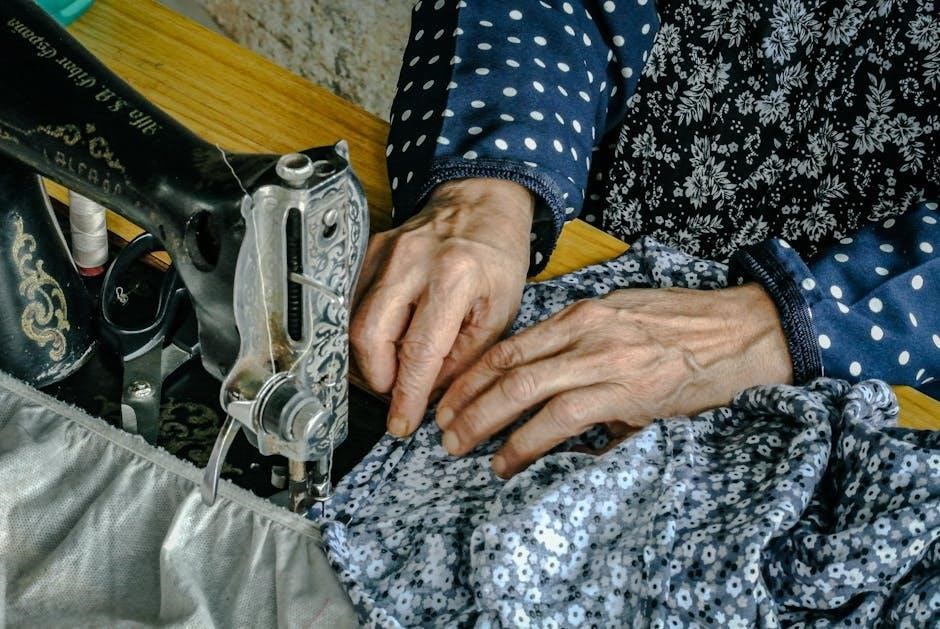
Reading and Interpreting Singer Sewing Machine Manuals
Understanding technical language, model-specific jargon, and visual diagrams in Singer manuals is crucial for proper machine operation and maintenance, ensuring users can decipher instructions effectively.

Understanding Model-Specific Instructions
Singer sewing machine manuals provide detailed, model-specific guidance tailored to the unique features and mechanisms of each machine. These instructions help users navigate the complexities of their particular model, ensuring proper operation. From threading techniques to stitch selection, the manuals are designed to address the specific needs of each Singer machine. Understanding these instructions is vital for both novice and experienced users, as they often include tips for maintaining performance and troubleshooting common issues. By following model-specific advice, users can maximize their machine’s potential and enjoy seamless sewing experiences. This tailored approach ensures longevity and optimal functionality for vintage Singer machines.
Deciphering Diagrams and Technical Drawings
Singer sewing machine manuals often include detailed diagrams and technical drawings to help users understand complex mechanisms. These visuals are crucial for identifying parts, troubleshooting, and performing repairs. Diagrams typically highlight components like gears, belts, and tension assemblies, while technical drawings provide step-by-step assembly or adjustment guidance. Users can reference these illustrations to locate specific areas of their machine, ensuring accurate repairs. Color-coded or numbered labels simplify understanding, making it easier to follow instructions. Familiarizing oneself with these diagrams enhances the ability to maintain and restore vintage Singer machines effectively, even for those with limited technical expertise.
Importance of Following Safety Precautions
Singer sewing machine manuals emphasize the importance of following safety precautions to ensure safe operation and prevent accidents. Vintage machines may have sharp parts, heavy components, or outdated electrical systems, posing risks if mishandled. Manuals provide clear guidelines to avoid injuries, such as keeping loose clothing tied back and avoiding contact with moving parts. Proper maintenance, like regular oiling and cleaning, also prevents mechanical failures. Adhering to these precautions not only protects the user but also preserves the machine’s functionality. Ignoring safety advice can lead to damage or harm, making these guidelines indispensable for owners of old Singer machines.
Singer sewing machine manuals are invaluable for restoring, maintaining, and operating vintage machines. They preserve craftsmanship, ensure safety, and connect enthusiasts to sewing history, fostering creativity and heritage.
Final Thoughts on the Value of Singer Sewing Machine Manuals
Singer sewing machine manuals are indispensable for restoring, maintaining, and operating vintage machines. They provide detailed instructions, troubleshooting guides, and parts diagrams essential for preserving these heritage devices. Beyond practicality, manuals connect enthusiasts to the rich history of sewing, offering insights into craftsmanship and innovation. By following these guides, users can unlock their machines’ full potential, ensuring longevity and functionality. Manuals also foster community among collectors and hobbyists, facilitating knowledge sharing and appreciation for vintage sewing. Their value lies not only in utility but in the stories and traditions they help sustain.
Encouragement to Preserve and Use Vintage Sewing Machines
Preserving vintage Singer sewing machines is a rewarding endeavor that connects us to the past while promoting sustainability. These machines, often built with superior craftsmanship, offer a reliable and eco-friendly alternative to modern disposable appliances. By restoring and using them, enthusiasts can appreciate the heritage of sewing and create something meaningful with history. The satisfaction of breathing new life into an old machine is unparalleled, making it a worthwhile hobby for crafters and collectors alike. Embrace the joy of working with timeless tools that continue to inspire creativity and self-sufficiency today.
Comments